Virtually every SaaS brand in existence now uses content as part of their marketing strategy.
Everyone is vying for a piece of the $157 billion SaaS market.
A quick scan of any standard SaaS website will reveal a “Resources” section with at least a handful of blog posts, possibly a “Knowledge Base,” and maybe even an ebook or two for good measure.
But let’s be honest: Most of this ‘valuable content’ isn’t very exciting.
A lot of it is downright boring. But it doesn’t have to be this way.
We’re a content marketing agency that has clients paying us tens of thousands each month.
So if you’re a SaaS company or SaaS marketer, please accept this blog post as my formal request that you step up your content game.
Why SaaS Brands Need Content Marketing
If you’re not yet using content (or if your existing content doesn’t seem to be doing much for your marketing or sales), you might be wondering if it’s even worth the investment.
In short, the answer is yes.
That said, I’m willing to acknowledge the fact that as a content writer myself, I might be biased.
So with that in mind, here’s a basic rundown of the role content can play in your marketing strategy and lead generation for your SaaS product:
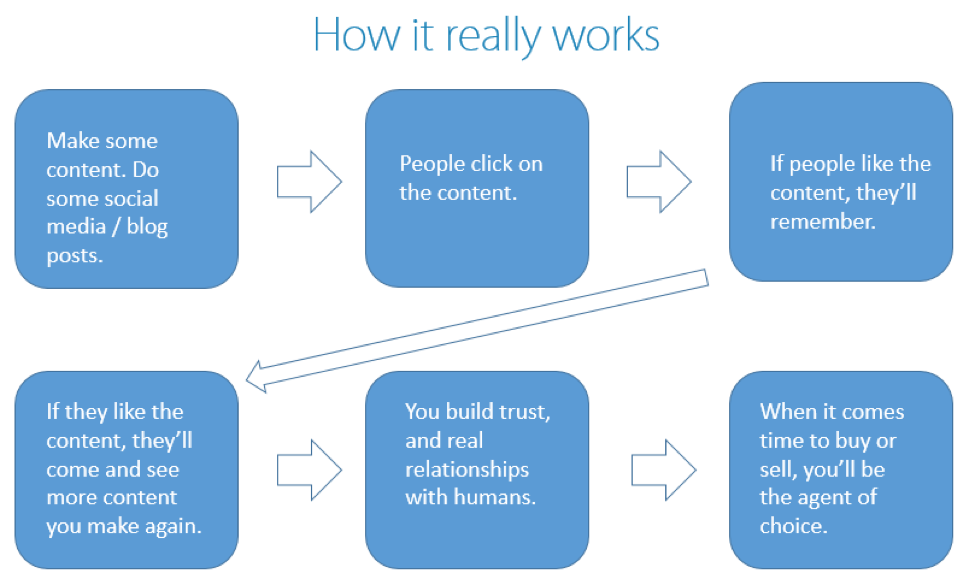
Essentially, content allows you to take a less overtly “sales-y” approach to reach new customers and positions your brand as part of the research process.
This way, when a potential customer is ready to invest, your product will be the obvious choice.
Take MasterClass, for example, where loyal subscribers pay an annual membership fee even if there isn’t a free trial available. Their secret? There’s none. Just have quality, engaging content that’s worth the cost.
Now, you might be wondering whether your target audience really spends time reading content from the brands they’re considering buying from.
But considering that 47% of B2B buyers read 3-5 blog posts or content pieces before speaking with a salesperson, there’s a very strong chance that they do.
And this is true for your target audience whether your company is creating content or not — meaning that if you aren’t, they’re likely getting the content they want from your competitors.
I don’t think I need to go into too much detail as to how this puts you at a competitive disadvantage.
But beyond helping you keep up with others in your industry, content can also have an extremely high ROI for your business.
That’s because, unlike other digital marketing strategies, it doesn’t involve paying for space.
Now, to be clear, to creating content that’s great can involve significant initial investments.
These investments can either come in the form of money if you opt for content writing services, or in time (and possibly blood, sweat, and tears) if you choose to write it yourself.
But once you publish it on your company’s site, it costs nothing to keep it there.
And as long as you’re creating “evergreen” content that won’t cease to be relevant within a few months, it can continue to generate leads and revenue for years to come.
For example, Francois Lanthier of Snipcart credits content for turning organic traffic into the company’s main acquisition channel.
By building a blog around the brand’s conversion funnel, Snipcart was able to create an extensive library of content tailored to their audience, and steadily increase the amount of qualified traffic they earned as a result.

Compare that to standard advertising channels, which stop producing results the second you stop paying for ad space, and the advantage is clear.
BUT — and this is a major but — getting these kinds of results requires making content that your audience wants to read.
At this point, most SaaS companies are well aware that buyers are doing research before committing to a product.
They know that they need to be targeting information-based keywords, and reaching users early in the process.
Unfortunately, most of their efforts come in the form of boring, “listicle”-style articles.
Worse yet, some brands simply add keywords with informational intent to their AdWords strategies.
For example, consider the query “how to keep track of business expenses.”
It’s relatively safe to assume that a user searching for this phrase wants to learn… how to keep track of their business expenses. (Duh.)
More importantly, the fact that they’re looking for this information likely makes them a potential customer for bookkeeping services or software — meaning that this could be an excellent topic for any SaaS company in the finance space to target in their content marketing strategy.
So, what would that searcher find?
As of this writing, the top four results are all PPC ads from well-known brands.

Now, as a searcher, you might expect that because these results showed up for your question, clicking on them would provide an answer.
So let’s see if that’s the case.
Here’s what Zoho has to offer:
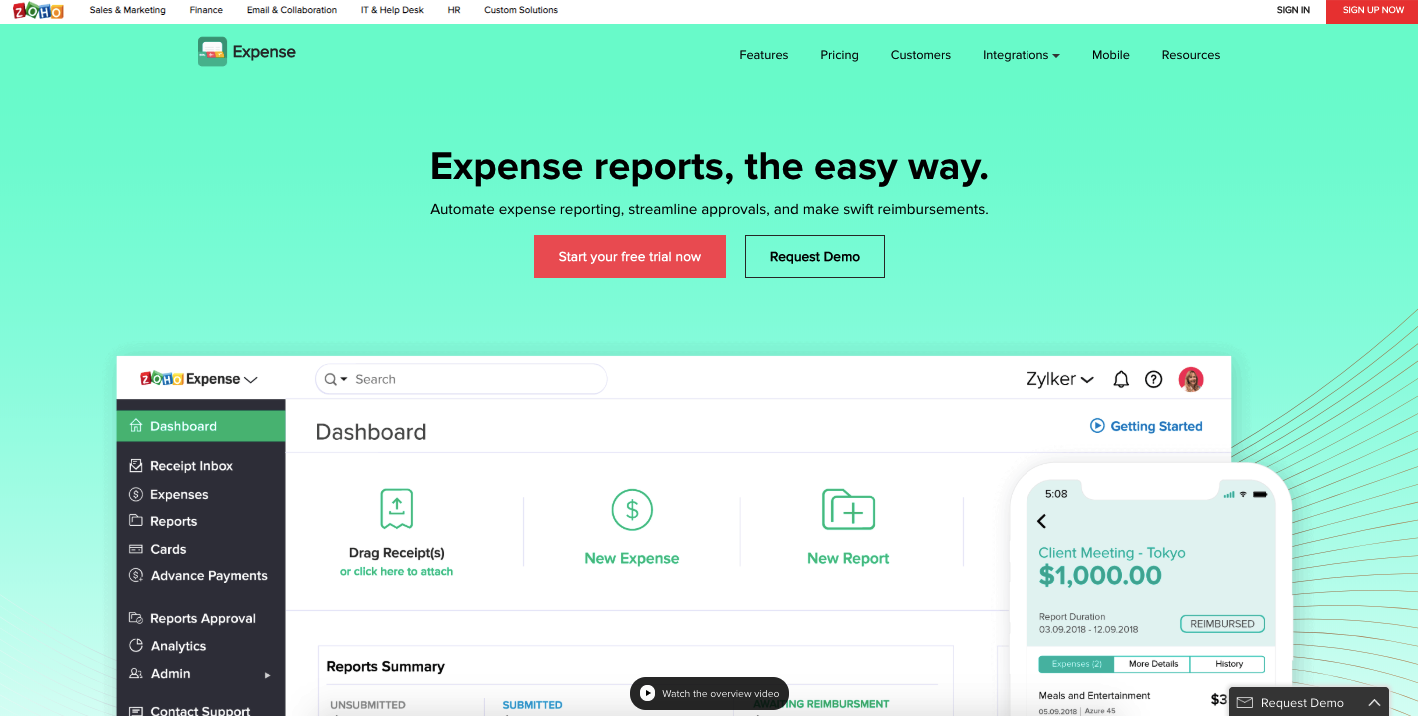
… and Xero:

… and Concur:

… and, finally, Netspend:
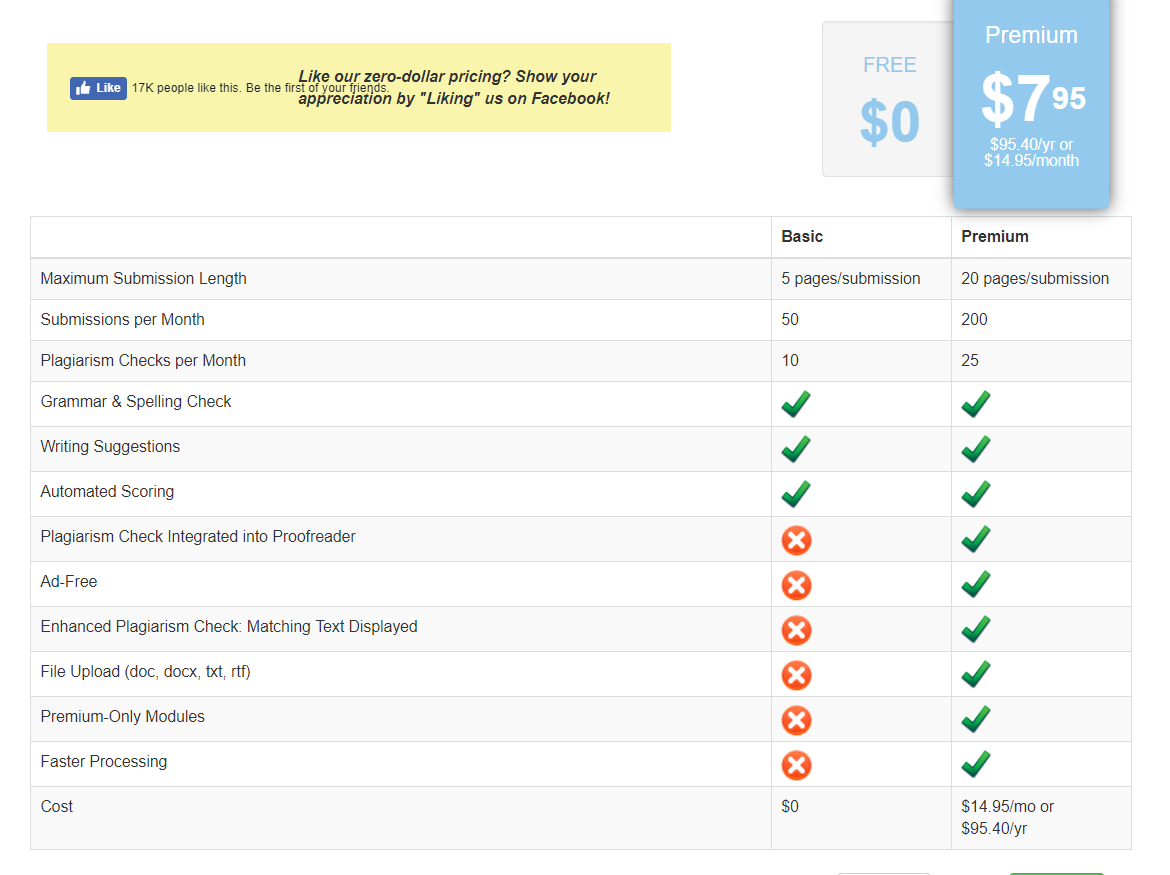
Not a single one of these pages teaches readers how to keep track of their business expenses.
Unless, of course, you count “Sign up for a free trial of our product!” as an answer.
Now, to be clear, that could be a valid call to action if any of these companies took the time to explain how their platform helped users manage expenses.
Instead, they all expect visitors to jump straight to a conversion, even before they address their question.
That’s not helpful to anyone.
So if your idea of content looks anything like those examples, please don’t waste your (or your audience’s) time.
But if you’re willing to put in the time it takes to create resources that actually help prospective buyers, content can absolutely be a beneficial addition to your marketing strategy.
A 5-Step Process for Content That Won’t Put Readers to Sleep
Most SaaS marketers have great intentions when they first launch their content marketing strategies.
But those intentions mean very little to readers when they’re struggling to keep their eyes open through the first paragraph of a blog post.
So before you open up WordPress and start drafting the internet’s one millionth “how-to” guide for a basic task related to your industry, you need to figure out how to create content your audience actually wants to read.
Fortunately, you don’t need to rely solely on your creative thinking abilities to make this happen.
Instead, you can use the following five-step content marketing guide to select worthwhile topics and create the kind of resources that will move you closer to your marketing goals.
1. Do Your Research
Every content marketing strategy needs to begin with research.
Now, if you’re more of a creative type, you might be inclined to brush off this suggestion. You might think that your imagination is a better resource for original ideas.
And even if you don’t exactly consider yourself creative, you might be thinking that as the founder (or marketer, or whatever) of your product, you know what kinds of information should go along with it better than anyone else.
And that might be true.
But it doesn’t matter.
You could create the best, most comprehensive resources your industry has ever seen — but if no one wants to read them, they’re useless.
You can avoid this by using data to select topics that your audience has already shown interest in. Look at organic search results for user intent, and in particular check search volume for topics. This will give you an accurate read on the types of content people actually want.
This is an approach that works.
Adobe CMO Ann Lewnes calls the brand’s commitment to consumer insights, “the secret sauce to measuring content,” and says that data helps their marketing team determine the best ways to engage with customers.
And it would be hard to argue that Adobe isn’t a creative brand.
In fact, the company’s CMO.com publication has been cited as an excellent example of SaaS content marketing by several top marketing blogs — and that’s all thanks to data.
So this isn’t a step you want to skip in the decision-making process.
Fortunately, it doesn’t have to be all that complicated.
First, you can start with Google’s Suggest feature.
Search for a keyword or phrase related to your product, then scroll down to the bottom of the page. Here, you’ll see a list of similar searches, based on real user data. This will also give a read on keyword difficulty (meaning how hard it is to compete with other sites for in organic search).
For example, sticking with that same expense tracking example, let’s say you’re an accounting software provider and want to help your target audience accomplish this goal.
A quick search for the phrase shows the following related topics:
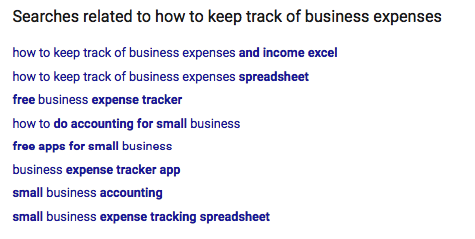
Of course, you’ll want to consider the intent behind each of these searches before adding them to your list of content ideas.
But as long as they’re relevant to your target audience, you can create content around them with confidence that there’s interest in these topics.
And as you scope out the search results for potential content topics, you’ll also want to take a look at the “People also ask” box.
For example, let’s say you’re considering targeting the keyword “how to create a professional invoice,” and see the following suggestions:

While these questions often aren’t different enough from the original search to warrant an entirely separate piece of content, many of them will be perfect secondary keywords.
This means that including them as subheaders on the page could not only help you more thoroughly address searchers’ needs, but also improve your chances of ranking for the primary keyword.
Then, once you’ve thoroughly exhausted Google’s suggestions for your content, it’s time to take a look at what your competitors are doing.
If you’re not already doing this, you’re about to be pleasantly surprised by the value of getting content ideas from your competitors.
Using a tool like SEMrush, search for a competitor’s domain name, and take a look at their organic keyword report.
This will show you all of the keywords they’re currently ranking for, as well as how much traffic each of those keywords bring to their website.

Again, you’ll want to do a quick relevance check before adding any of these to your list.
After all, if one of your competitors offers a feature that you don’t (and you have no intention of adding), targeting a keyword related to that feature ultimately isn’t going to earn you any customers.
But if you’re able to create high-ranking content for the keywords that are relevant to your product, this is an excellent way to take a more competitive approach to content.
Finally, one of the most effective strategies for finding great content ideas is also one of the simplest: Talk to your customers and sales reps.
Your existing customers are one of your most valuable marketing resources because they know firsthand what the research process looks like for your target audience.
Ask them what kinds of information they sought during the buying process, what problems led them to seek your product, and what questions they had prior to using it.
What they wanted to know will immediately guide you to the right search intent to aim for with your content.
Each of these questions and problems plays a role in your target audience’s research — meaning that content addressing them is a prime opportunity to connect with prospective buyers.
2. Consider All Stages of the Buying Process
So, you have an extensive list of content ideas.
It’s time to start working your way through them — right?
Not so fast.
Once you’ve compiled a list of topics, you’ll need to spend some time developing a content strategy and figure out some content marketing metrics.
I realize that this might not sound fun. And I’m sorry.
But you don’t want to skip this step.
While tackling your list of ideas without a strategy might bring in some traffic and leads, it’s basically the equivalent of throwing handfuls of spaghetti at the wall and hoping that something sticks.
(In this scenario, the spaghetti is your content, and the wall is your audience’s informational needs. In case that wasn’t clear.)
You’ll get much better results if you structure your approach around your target audience and buyer personas.
Consider what their search intent is when they type each of your target keywords, and where they might be in the buying process as they search for that information.
Then, think about what they might need next.
Now, I’m not asking you to be a mind reader (although that could help).
Instead, take a look at your content ideas in terms of where they fit into the sales funnel.

For example, a visitor who’s interested in a technical, in-depth article on the advantages of a specific feature you offer is likely much farther along in the process than one who’s reading a blog post with a basic overview of your industry.
And your strategy needs to include content for both of them.
If your content only targets awareness-level keywords, you might see lots of traffic. But you’ll likely have trouble retaining those visitors once they have more complex informational needs.
And if your content only targets keywords with purchase intent, you might achieve fairly high conversion rates. But if you only attract a dozen or so visitors per month, your sales numbers will remain low.
So before you begin creating (or hire someone else to do so), make sure that your strategy includes topics for your audience at every stage.
And depending on the nature of your product, you might also need to take different segments within your target audience into account.
For example, as a meeting / project management tool, it makes sense that Calendar focuses a lot of their content on productivity:

But because their audience is made up of both personal and professional users, their content strategy involves different resources for each.
Trello follows a similiar path. This personal productivity guide is likely beneficial to readers who are considering using the platform to manage their day-to-day lives better:

These resources each serve different, but equally important, roles within the brand’s strategy.
So as you fill up your editorial calendar, make sure that you’re doing so strategically, and in a way that addresses all of your target audience’s needs.
And as you look for ways to build out your resources, you can even take a page out of Credo’s book and organize your content by persona.
Plus, this organizational structure can help you build out your content in a more strategic way.
As Credo founder John Doherty explains, you can begin by conducting a survey or using a data analytics tool to identify three or four of your users’ most common issues or needs.
Then build out separate pages addressing those issues, tailored to each segment of your audience.
So, going back to the accounting software example, let’s say your target audience is a combination of local retailers, ecommerce retailers, and startups, and you know that keeping track of expenses is a common issue for all of them.
You could create three separate pages addressing the topic, each tailored to the unique challenges within each of those business models.
This way, you’re creating content that’s not only helpful but hyper-targeted to individual segments of your target audience — so they’ll never have to wonder whether your product is equipped to meet their needs.
3. Create Something Unique
Once you’ve developed a strategy, it’s time to start creating.
And this is where the real work starts.
Although a thousand or so words of copy would’ve been enough to earn you a top spot in search results for most keywords a few years ago, that’s no longer the case.
And thank all of our lucky stars for that.
Today, searchers no longer have to dig through pages of poorly-written results to find one that adequately addresses their question.
Of course, from a content creator standpoint, this means that you’ll need to put in more work to achieve any level of visibility.
But when it comes down to it, earning the kind of response you want from your content requires creating something that’s not only high in quality but offers something different from all of the other resources already out there.
In simpler terms: Go big or go home.
That said, it’s important not to confuse quality with word count.
While it’s true that the average first-page result is over 2,000 words long, writing a lengthy post certainly doesn’t guarantee you a top spot in search results.
In fact, many brands have seen excellent results from content formats other than written copy.
Just take a look at Shutterstock’s 2018 Creative Trends Report.

The company analyzed user search data to identify trends in design, then created a report of the top 11 for 2018.
The final product is an interactive infographic, complete with data for each trend, as well as a unique video for each, along with links to images and footage that readers can use in their own projects.

All told, the report clocks in at just over 1,700 words.
There are other pieces of content on creative trends with higher word counts than this. But I’d be willing to bet that none of them are even close to being this engaging.
So while thoroughly covering a topic tends to require high word counts, and it’s certainly not a bad idea to aim for a few thousand words, remember that ultimately, quality > quantity.
And even if you don’t have access to a wealth of user data like Shutterstock (or, you know, the marketing budget of a $760 million company), you can still find ways to take a more exciting approach to content.
This is true even if the basic concept behind a piece of content isn’t all that original.
For example, lots of SaaS companies publish customer success stories in some form. But MailChimp takes a more interesting approach than most by compiling customer examples into an interactive resource called “Look What You Can Do.”

Readers can filter by category, then browse real email content from other companies using MailChimp. And if any of these examples inspire them, the signup button in the left sidebar makes it easy for them to join the platform and create their own version.
And if your product doesn’t typically produce results that are visually interesting or fun to scroll through?
Not a problem.
Just take a look at Xero’s Accountant and Bookkeeper Stories:

I think most of us can agree that accounting software isn’t exactly the most exciting subject.
If you disagree with this statement, well… more power to you. Your finances are probably in excellent shape.
But for the rest of us, content like Xero’s that adds a personal element to a topic that could otherwise be dull makes for a much more interesting read.
And if an accounting platform can find a way to write content that’s this fun to read, there’s no excuse for your brand to be publishing boring blog posts — even if you don’t have the resources to be publishing the same volume of content.
Many content marketers make the mistake of believing that volume is the key to building a steady flow of traffic, but that’s not the case.
For example, when Karola Karlson of Aggregate started blogging about growth marketing, she aimed to publish two short posts every week, each featuring one tip, trick, or hack.
Then, she decided to experiment with a different approach by writing a long-form post on building an audience and driving long-term traffic. As expected, it took considerably longer to create — but drove more traffic than ten of her shorter posts combined.
After this revelation, she completely changed her strategy and started writing just one post every other week.
The result was significant traffic growth, as well as increased site engagement.
So if you’re worried that creating unique, in-depth content will take up a lot of your time and slow down production, you’re absolutely right.
But as long as the quality increases as the quantity decreases, less can certainly be more.
And you don’t have to stop there. Creating unique content for your business doesn’t have to be just blogging. In fact, it shouldn’t be. Creating new content like podcasts, quizzes, and tools can help you boost both authority and user engagement.
For example, take a look at this Restaurant Marketing Grader from Upserve:
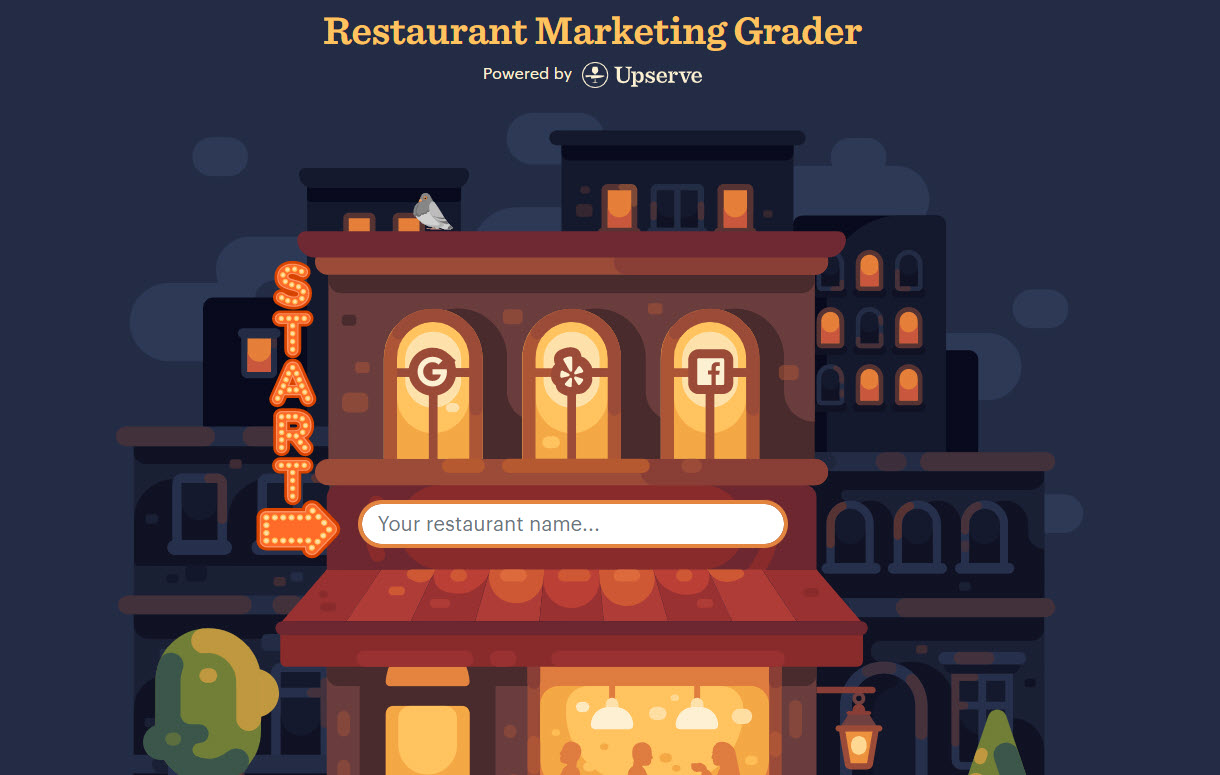
By inputting your restaurant name, the tool scans the web based on reviews, mentions, and social trends to analyze how impactful your current marketing strategy is.
Then, Upserve uses this is a bridge to connect with leads and sell them on their offering.
4. Show Some Personality
The early stages of a content marketing strategy are an excellent time to find a unique writing style and tone that work for your brand.
Consider what kind of personality you want your brand to have, and how that personality is different from that of your competitors.
And as you do this, just know that “professional” doesn’t count as a unique attribute.
In fact, if that’s the only descriptor you can use to explain your content’s style, I have bad news for you: Your content is probably boring.
This is especially true now that an increasing number of brands are becoming more comfortable expressing their real opinions on issues within their industries.
Basecamp, for example, does an excellent job of this on their Signal v. Noise blog. If you’re unfamiliar with the brand, check out a quick excerpt from their most recent post:

Controversial? Maybe.
But there’s no arguing that it’s memorable — and much more so than the standard listicle-style “X Tips for Being an Awesome Leader!!” posts that other brands seem to favor.
So before you start writing your next piece of content, think beyond what information you want readers to take away from it.
Think about what kind of impression you want to make for your brand, and what types of traits you want readers to associate with it. Then, look for ways to incorporate those traits into your writing.
This way, you can create something that not only conveys information but plays a role in establishing the reputation you want for your company — and sets you apart from prospective buyers’ other options.
5. Repurpose Your Content
Consumers now have more options than ever for engaging with content online. As a result, many of them have developed preferences for specific mediums and formats.
Some still prefer written content, while others learn better from video tutorials. Some look for brief posts that focus on a specific task, while others want comprehensive, start-to-finish guides for everything they’re hoping to accomplish.
And as a content creator, this might make you want to chuck your laptop out the window.
After all, shouldn’t mastering one format be enough?
Shouldn’t your audience be willing to read, watch, or listen to your content in whatever form it takes, as long as it answers their questions or provides the information they need?
Nope.
(Sorry.)
But this doesn’t mean you need to start from scratch to start using additional mediums. In fact, I recommend that you don’t.
Instead, you can maximize the value of the work you’ve already done by repurposing your content.
If you’ve already written helpful blog posts, turn them into email newsletters.
If you’ve published long-form articles, convert them into video scripts.
If you’ve created original graphics, upload them as slide decks.
You get the picture.
And if you’re wondering if this strategy will help your content marketing efforts, I strongly encourage you to check out Buffer’s blog post on their “No new content” experiment.
Though the brand typically has a steady editorial calendar, they decided to see what would happen if they stopped publishing original content altogether for 30 days.
During that time, they focused solely on repurposing old content into new formats. This included:
- Creating drip email campaigns from old blog posts
- Republishing content to Medium
- Creating audio and video content from blog posts
- Compiling shorter content into ebooks
For example, they took this already-popular blog post on hashtags:
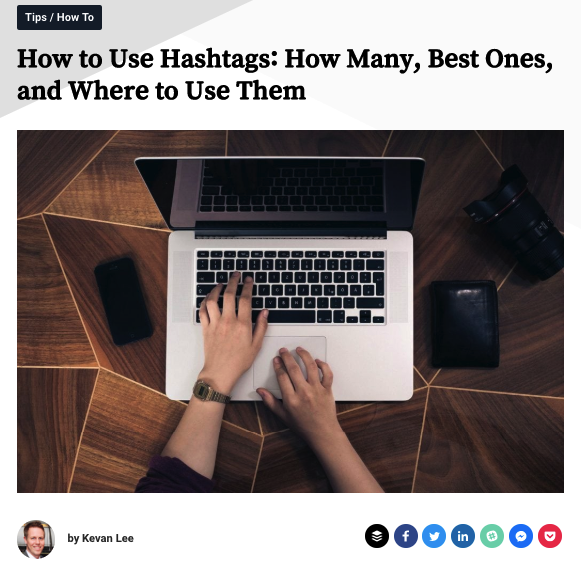
… and recorded it, word-for-word, as an audio clip:

So, how did it go?
Even after publishing no new content for 30 days (after normally publishing multiple blog posts per week), their overall traffic remained relatively steady, and their organic traffic actually increased by 4%.
Of course, this example comes from a brand that was already publishing content in multiple formats.
But even if you’re currently only creating one type of content for your audience, you can still repurpose each resource into several other formats.
For example, AdEspresso first explained social proof marketing with an “Ultimate Guide” blog post.

This post performed well with their target audience — but the brand decided not to stop there.
Instead, they got more value out of the content they’d already created by repurposing it as an ebook..
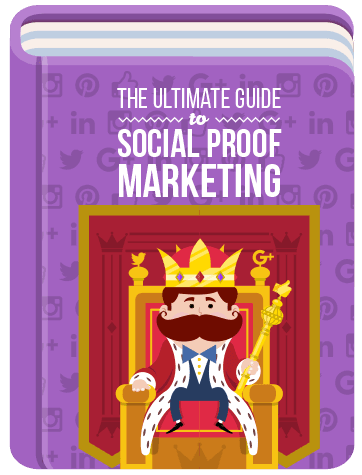
And as the company clearly states in their post on this strategy, all three resources contain the same material.
But did their audience mind?
Not at all.
The Slideshare generated an additional 3,900 visits in the first ten days, and the ebook earned 253 leads in the first few hours.
In total, these three pieces of content drove 11,376 visits in the first 30 days of their publication — a much higher number than any of them would have earned on their own.
So if you’re already putting in the time and effort it takes to create a valuable resource for your audience, there’s no reason not to maximize the value you get from it by publishing it in multiple formats.
You can improve your overall content ROI, while simultaneously giving all of your potential customers information in the formats they prefer.
Conclusion
Doing SaaS content marketing well isn’t easy.
But it also isn’t impossible.
Find out what your audience wants to know, and figure out how each of those topics fit into the buying process.
Then, create resources that uniquely address those topics, and sprinkle in some personality where you can.
And if you don’t have the time to do all of that yourself?
Well, …we’d love to hear from you.



